Utilisation of High Performance Concrete in Asia
Early developments of High Performance Concrete, HPC, have been emphasized on High Strength Concrete, HSC, for structural durability purposes. The later state of developments has been transformed to the area of constructivity and structural behaviours purposes.
Synopsis
Early developments of High Performance Concrete, HPC, have been emphasized on High Strength Concrete, HSC, for structural durability purposes. The later state of developments has been transformed to the area of constructivity and structural behaviours purposes. Recently researches and developments in Asia may be categorized into high strength concrete, flowable concrete and durable concrete. The higher the strength, the higher the stiffness and the ductility can be key performance of HSC, as which flowability, consistency workability and compactability shall be key performance of HPC. The durability by means of chemical, physical and mechanical actions shall be considered as long term performance during its design service life. The utilization of HPC in construction industries as for construction, structural, and durable purposes, shall be presented to demonstrate some contribution toward green construction concept of sustainability engineering and sustainable development as for social, economic and environmental advantages.
Introduction
Recent development of high performance concrete, HPC in Asia may be considered to be about the same path of that in the United States, the European community and the global trends. Early research work have concentrated on high strength concrete, HSC as polymer impregnated concrete and polymer concrete to obtain the strength up to 120 Mpa; as which the water reduction approach by means of chemical admixture and strength based gradation of the aggregates to obtain the strength up to 140 Mpa.
HPC of another approaches have emphasized on flowable advantages on constructivity purposes. The workability performance such as flowability, compatibility workable time, heat generation, consistency, and dimension stability have been controlled by cement constituent, mixed proportions and relevant admixtures.
The long term performance of concrete in durability of chemical, physical, and mechanical approaches have considered in research and development in Asia to support environmental friendly materials for sustainable development and to extend the design service life of the structures.
This paper intends to compile some research works on development and implementation toward utilization in construction industries for proper performance and most effective proficiency. Since construction industries are parts of building process that can be transformed or adopted to green construction of the global trends. The principle criteria of green buildings have required environmental friendly materials, conservation on natural resources and energy, extended the service life and promoting efficient construction techniques. Then utilization of HPC presented herewith will be a realistic approach for green construction. Some implementation examples shall be given to the most efficient application to demonstrate expertises.
Research and Development
Since most research works on HPC can facilitate some improvement in strength, workability and durability, then the studies have covered wide ranges from cement constituents, mixed proportions, manufacturing, test methods, concrete properties, relevant performance, and some enhancing applications.
High Strength Concrete
The polymer material should have offered high strength such as MMA -methyl meta-accrilate monomer with some cross-linking agents to achieve polymeric reactions and produce super high strength concrete. However, the concrete strength may be controlled not only by cementing agent but also by strengths and gradations of the aggregates as for workability and strengths. To improve strength of cement paste can be done by water reduction enhancing the W/C water to cement ratio of optimum hydraulic reaction; the HSC shall also be taken care of reasonable workability for transporting, placing, compaction and finishing, by means of appropriate aggregate gradation according to the resources. Key parameters to control the strengths shall be achieved by strength of coarse aggregate, proper ratio of coarse to fine aggregate of fineness modulus of regular mixed proportion of normal strength concrete and of the strength based gradation for high strength and ultra-high strength concrete. It should also be noted that tensile strength of cement paste shall be improved by adding some fibres into the paste. To increase paste strength, it will lead to some contribution to improve the strength of concrete.
|
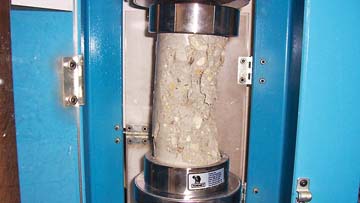
|
| The polymer material should have offered high strength such as MMA -methyl metaaccrilate monomer with some crosslinking agents to achieve polymeric reactions and produce super high strength concrete. |
Another alternatives of improving strength can be done by utilizing pozzolanic reaction from calcium hydroxide [Ca(OH)2] and some pozzolan such as silica-fume, fly ash, or other mineral admixtures the Calcium Silicate Hydrate (CSH) has formed by the pozzolanic reaction to gain concrete strength in the long run. In fact, the reduction of calcium hydroxide would have lead to support long term performance such as reduction of creep and shrinkage. Some reduction of alkality to enhance chemical durability so it may be concluded that the high strength concrete should be as follows:
- Compressive strength should be at least not less than 60 Mpa. Of 28 days strength.
- The early strength of 24 hours strength (one-day strength) shall be at least 50% of 28 days strength.
- Sufficient flow and slump to work with at least 1.5 hrs of working period prior to its initial sitting times.
- Sufficient dimension stability and resistance to durability of short term and long term performances.
Flowable Concrete
The aggregates shall be covered by cement paste and by its floating action of the paste, then concrete can be flown as the liquid. The plasticity of the paste and the mixed have been evaluated by optimum mixing proficiency in energy consumption in manufacturing, transporting, and placing of HPC. Further developments in Thailand, by partially substitution of fly-ash to replace regular cement Type-I can be used in similar manner of blast furnace cement to produce flowable concrete. Other than cement paste properties, the mixed proportion concerning cement content, aggregate gradation, water to cement ratio, and the admixtures have played the major roles on studied works along with fresh concrete properties and the hardened concrete properties. One of the most noticeable performances of flowable concrete of which the concrete shall be densed without compaction to ensure structural integrity and the homogeniosity with its reliable structural behavioural performance throughout its design service life.
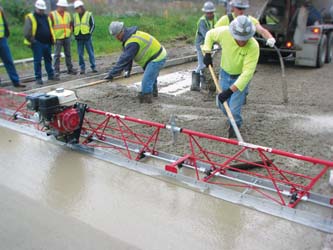 |
Some other performance at the early stage may be also taken into consideration of workable periods or its setting times along with some heat gains from hydration reaction of accumulated temperature to create micro cracks in concrete mass. The cement constituents, mixed proportions, and some mineral and chemical admixtures may be also needed to accommodate the consequences of specific construction techniques. The zero-slumped concrete can be also considered as high performance concrete for roller compacted construction of massive structures of foundation, dam, or pavement without shutters or formwork. The recent research works on these aspects have concerns with partially cement substitution in concrete mixes to obtain minimum content associated with sprayed water to the most appropriate compacting efficiency and reasonable heat generation during the curing process. Proper control of strength development, the dimension stability due to creep and shrinkage as time dependent behaviours, to be kept in mind. The most outstanding feature of flowable concrete should be concluded as:
- For flowable concrete, it should be at least 50 cm. flow or 20 cm. slump.
- For zero-slump concrete, it should be proper gradation to achieve compactability of at least 95% proctors.
- The compressive strength shall not be at least 25 MPa or otherwise 2.5 MPa of modulus of rupture.
- A reasonable heat gain as cumulative temperature rise not more than 800c.
- Sufficient dimension stability by means of creep and shrinkage to avoid some micro-cracking
Durable Concrete
Some recent studies on durable concrete have been conducted not only as for the concrete material but also as for the structural concrete performance. By any means, the structural concrete may be categorized into 3 groups of chemical, physical, and mechanical durability. The chemical durability can be emphasized on cement chemistry of cement types or cement constituents with a combination of some modified ones and some mineral admixtures. The key parameters for chemical reaction of hydraulic cements and water would be concerned with alkality reduction and enhancing contribution to anchorage of calcium silicate hydrate (CSH).
| The mixed design of the proportions shall be carried out in the usual way to serve the manufacturing, transporting and placing process as which the reasonable compressive and flexural strengths shall be achieved. |
|

|
The approaches can be done by reducing amount of C2S di-calcium silicate and C3S tri-calcium silicate in cement and by activating pozzalanic reaction with some pozzolan. By thus means that the Ca(OH)2 calcium hydroxide will be retarded some hydroxide (OH-) from deterioration process of thus durability. The physical durability as thermal expansion, abrasion or hardness, erosion and dimension stability, attributed by thus control aggregates of cement paste and mixed proportions. The aggregates should be high strength, low permeability and high abrasion resistance. The paste should have low water to cement ratio with association of pozzolanic materials of silica-fume, fly ash, blast furnace slag or glass powder, etc. The mixed design of the proportions shall be carried-out in the usual way to serve the manufacturing, transporting and placing process as which the reasonable compressive and flexural strengths shall be achieved. The mechanical durability may be considered in terms of the strengths and its stiffnesses or the modulus of elasticity (Ec). Extreme fibre stresses of strains especially in tension should be controlled in certain respective magnitude especially when they are subjected to some alternative loads, dynamic loads of wind or earthquake, vibrations or fatigues of that similar characteristic. Some micro cracking of young concrete at the early age shall be avoided and prevented from extreme exothermal during its setting time and proper developed strengths to be allowed for removing of shutter or formworks. Anyway, the durable concrete may be concluded as such:
- For durable concrete, it should be at the compressive strength of not less than 300 kg/cm2.
- Alkality in terms of calcium hydroxide Ca (OH)2 should be less than 10% of cementitious at 28 days of age.
- The abrasion resistance should be at least 0.05% of volume losses.
- Sufficient dimension stability by means of creep and shrinkage to avoid some micro-cracking.
Utilization in Construction Industry
Some researches and developments have been carried out to serve the purposes of direct application toward extending the service life in the operation and maintenance period of which the rehabilitation and strengthening of the structural concrete. However, some of them may be slightly deeper in theoretical or technical, but they can be some supports to the utilization in construction industry by some ways or some how. From those 3 categorised of high performance concrete, HPC of strengths, flowability, and durability, some utilization approaches can be made as their out-standing features, properties and the characteristics:
| Self Compacting - flowable concrete as self levelling of fluidity can be used in very heavy and congested reinforcement structures with slightly compaction or even without compaction to obtain dense and homogeneous concrete. |
|
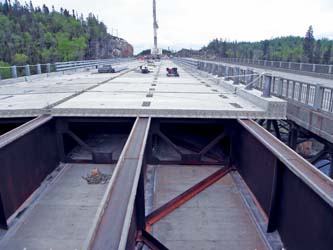
|
A. Construction Purposes
- Tremie Concreting - flowable concrete always required especially for underwater concreting or bored pile concreting of wet process. Key parameters to be controlled would be flowability of self compaction and the consistency of preventing from contamination to surrounding water or slurry. Immersing depth and relative rate of pour should be correlated to the most effective production. The setting time and time to remove the casing where its requirement should be co-operated between the specification and actual control during thus concreting operation.
- Self Compacting - flowable concrete as self levelling of fluidity can be used in very heavy and congested reinforcement structures with slightly compaction or even without compaction to obtain dense and homogeneous concrete. The key parameter shall be only flowability and the consistency of preventing from segregation. The parameter such as strengths setting times and dimension stability may also be required according to the relevance structural performance.
- Roll Compacting - Roll compacted concrete with its zero slump is used for plain concrete without any reinforcement as for pavement or dam construction. These types of construction techniques are not require the shutter or formwork. Key parameters should be related to compactivity, gradation of mixed proportions and water content. Cement contents and fly ash proportions should be controlled to proper compaction index, appropriate concrete strengths, and moderate of roll compacted concrete should be monitored and controlled to assure the structural performance.
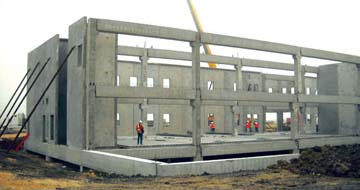 |
- Prefabrication/ Precast - Constructivity of prefabricated components or precast members may be contracted on flowability during placing concrete, but they may required high early strength enhancing sufficient strengths and stiffness during their removing shutters, lifting and handling prior to the erection or fabrication. Key parameter of thus concrete should be the flowability, the stripping strength, dimension stability and the concrete surface texture and appearance.
- Mass Concreting - There are three major parameters to be controlled for mass concrete construction. First parameter may be related to heat generation subject to exothermal of chemical reaction of cement and waters that can be estimated by cement content, and the cement types. The second parameter may be size or mass pouring with related rate of pour and sequence of concreting as that for cumulative heat gain and distributed to nearby mass of conductivity and connectivity. The last parameters shall be concerned with provision measures for heat transfer by circulated water through pipeline to bring that heat out or by protected from heat transferring by some insulation or heat barrio. Total control of mass concreting is to prevent from micro-cracking due to the different thermal distributor.
- High Early Strength Concreting - The high early strength concrete may also be used for some repair works of such workable time and curing time have been controlled by operating function of the structures such as bridge deck or road pavement of heavy traffic of some big city. The early strength of only 3 to 6 hrs have to be achieved with specific period to close down the traffic for thus operation of hacking the existing one, prepare for placing, then fabricated concrete to furnished products and finalized by opening to traffic within its curing time of the required strength. These techniques required best practice not only for HPC but also for repair operation of high performance as well.
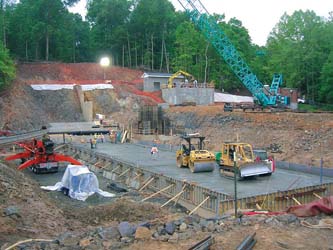 |
B. Strength Purposes
- Column - Utilization of high strength concrete for columns should be one the most effective implementation of high strength in compression in association with flexural strength. Direct application would be as the benefit to improve strength capacity significantly as 2 to 3 times of normal strength concrete depends on the strengths. By thus means, the stiffnesses and the ductility will also be improved, then the member sizes can be reduced significantly. The amount of the reinforcement will also be remarkable reduction.
- Prestressed Concrete - The prestressing members of beams and girders can be significantly improvement by means of strengths and stiffnesses. Prestressed concrete construction of pre-tensioning or post-tensioning and of precast components or cast-in-situ construction has been developed to accomplish the most benefit of structural behaviours for strength, serviceability and durability. The key performance indicator shall be monitored and accommodated the design service life.
|
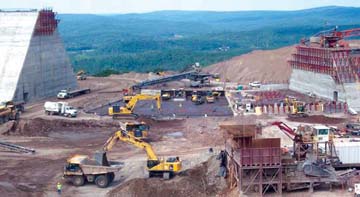
|
The improvement of structural ductility can be achieved by strength and deformation of the structures. Utilization of high strength concrete
and some pre-stressed or pre-cambered structural members to accomplish thus behaviours. |
- Composite Structures - The composite members of high performance concrete and structural steel can be advantageous in combination actions of high strengths in compression, tension, shear, bond and some others related. Some other means of composite actions of HPC with prestressing tendons or fibre reinforcement may be categorized as mixed structures of thus specific application and innovation.
- Rehabilitation and Strengthening - Rehabilitation and strengthening the existing structures during the operation and maintenance can be categorized either in construction, strength or durability purposes. Improvement of structural behaviours during the construction and the finished structural members shall be considered as the long term per-formance to extend the design service life. Pre-camber or pre deformed flexural members can be also employed for rehabilitation or strengthening of the beams or girders.
- High Ductility - The improvement of structural ductility can be achieved by strength and deformation of the structures. Utilization of high strength concrete and some pre-stressed or pre-cambered structural members to accomplish thus behaviours. Nevertheless, the structural performance of such means can be used for high fatigue resistance as well as for the dynamic resistance subjected to wind and earthquake action.
C. Durability Purposes
- Marine Concrete - High performance concrete for marine environment should have been a low alkality of calcium hydroxide, high permeability of low water to cement ratio, and high mechanical resistance of high strength. This type of concrete shall be utilization for marine structures of port and harbour coastal structures of break-water or bridge or retaining structures, and some off-shore structures of platform, bridge piers or oil-rigs. In construction phase, they may be cast on-shore or near shore, to be hauling and tugging to places and then be sinking on to its foundation.
- Chemical Resistance - High performance concrete for chemical resistance as for chloride, sulphate and carbonation resistance. Principle features should be co-operative action between low alkality actions of cement consistent and the pozzalanic reaction should also be less water to cement ratio to achieve high permeability along with high waterproofing. High strength properties shall also contribute some preferable structural behaviour in reducing cracks, improving ductility, and prolong some fatigues life.
- Corrosive Protection - Utilization of HPC for corrosive protection can be parts of newly constructed structural members or can be a part of covering or jacketing of existing structures. Primary features of corrosive protection should be about the same as those for chemical resistance of chemical durable and physical durable. The most effective protection can be made by means of concrete cover by low alkality and high permeable concrete. Thickness of concrete cover should be at least 50 mm. for protective of at least for 50 years of design service life. Some additional measures of cathodic protection may also be required if the monitoring records have shown some aggressive deterioration are made.
- Abrasion Resistance - High performance concrete for improving abrasive resistance can be overlaid portions of concrete cover or jacketing portions of structural members. The main features of the HPC should be figured out for high abrasive resistance, more surface hardness, higher tensile strength and also be a shrinkage compensating characteristics. The non-shrink or low-shrink properties are required to adhere the interface of the existing and the remedial concrete to integrate behaviour of composite action of the single mass preventing from thus any disintegration.
- Fire Endurance-High performance concrete of thus for fire resistance and high durable against fire should be less porosity, poor conductivity and excellent insulation. Air voids within the concrete mass should be well distributed by proper mixed design. The mineral ingredient of coarse and fire aggregates should also be tested to serve some limit states of fire endurance. Fire resistance limit states for some structural components have been specified and regulated by Building Control Act in Thailand. Test procedure and the Code of Practice should be conformed to such practice.
Conclusion
With regards to tremendous efforts on research and development in the field of HPC not only in Asia but also the global views can be applied for building process of construction industry. For the most outstanding works in utilization in concrete industries can be concluded as follows:
- High performance concrete ll (HPC) in each parts of the world may be defined the performance of slightly different in accordance with its utilization purposes.
- The research and development works may be categorized the HPC into 3 groups according to their developments as high strength concrete, flowable concrete and durable concrete.
- The utilization of high performance concrete in construction industries can be at different in purposes of construction techniques, structural performance and the durability to extend the service life.
- Trends of HPC in construction have been on the right path of green construction for sustainable development.
Reference:
- Limsuwan, E. "High Performance Concrete" Text Book (in Thai), Chulalongkorn University 2012
- Ozawa K., Maekawa K., Kunishina M. and Okamura H., "Development of High Performance Concrete", Concrete Laboratory Department of Civil Engineering, University of Tokyo, 1991
- Chakpaisarn W., and Limsuwan. E., "Development of Shrinkage Compensating Cement", Proceedings of the 1st National Concrete Conference, Engineering Institute of Thailand, Kanchanaburi, May 2003
- Haleerattanawattana P., and Limsuwan E., "Mix Design for Ultra-High Strength Concrete on Strength-Based Gradation", 8th International Symposium on Utilization of High-Strength and High-Performance Concrete, Japan Concrete Institute (JCI), Tokyo, Japan, Oct. 2008.
- Limsuwan, E. "High Performance Concrete, Thailand Practice" Asian Concrete Federation E-Newsletter Vol.4 NO.1, June 2010.
Acknowledgement
This paper was published in the proceedings of the R. N. Raikar Memorial International Conference and Dr. Suru Shah Symposium on 20-21, December 2013 at Hotel Hyatt Regency, Mumbai- Advances In Science & Technology Of Concrete, organised by the India Chapter of American Concrete Institute.
About Author
 |
| Dr. Ekasit Limsuan |
Professor in Structural
Engineering, Chulalongkorn University.
Expertise in HSC / HPC Concrete, Precast Construction, Structural Concrete, Forensic Engineering and Sustainability Engineering. Currently in expert group of Environment Impact Assessment Chairman of IABSE Thailand Group and formerly Vice-president of IABSE, and Chairman of ACI-Thailand Chapter.